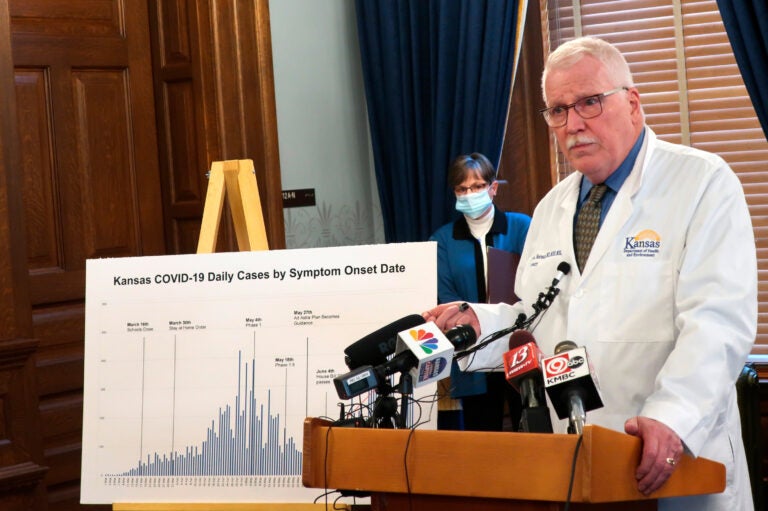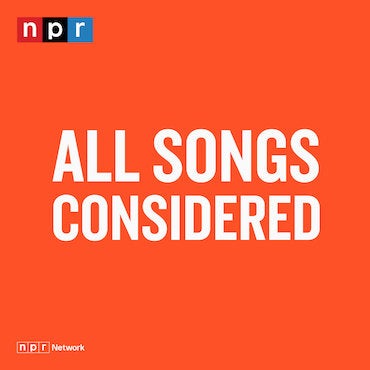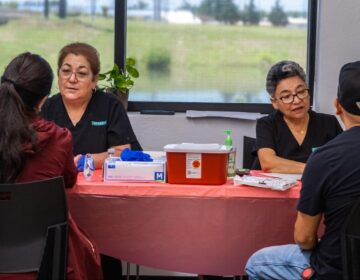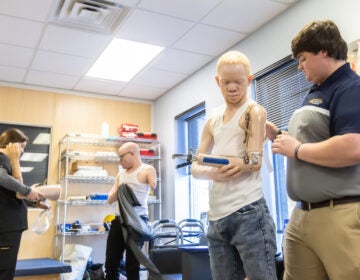With CDC out of data collection, some state hospital groups can’t get COVID-19 info

Dr. Lee Norman, secretary of the Kansas Department of Health and Environment, discussed the resurgence in coronavirus cases in the state this week. The state hospital association fears there will be delays in getting coronavirus data under new federal rules. (John Hanna/AP)
Just as the number of people hospitalized for COVID-19 approaches new highs in some parts of the country, hospital data in Kansas and Missouri is suddenly incomplete or missing.
The Missouri Hospital Association reports that it no longer has access to the data it uses to guide statewide coronavirus mitigation efforts, and the Kansas Hospital Association says its hospital data reports may be delayed.
The Trump administration this week directed hospitals to change how they report data to the federal government and how that data will be made available.
In an email, Missouri Hospital Association spokesperson Dave Dillon called the move “a major disruption.”
“All evidence suggests that Missouri’s numbers are headed in the wrong direction,” Dillon wrote. “And, for now, we will have very limited situational awareness. That’s all very bad news.”
The absence of the data will make it harder for health and public officials, as well as the general public, to understand how the virus is spreading.
“It’s hugely problematic,” says Dr. Karen Maddox, a public health researcher at Washington University in St. Louis. “The only way that we know where things are going up and where things are going down and where we need to be putting resources and where we need to be planning is because of those data.”
The White House instructed hospitals to report data to the Department of Health and Human Services through a new system created by a Pennsylvania-based company, TeleTracking, instead of sending the information to the Centers for Disease Control and Prevention, as they had been doing.
The directive came as a surprise to hospitals, according to Kansas Hospital Association spokesperson Cindy Samuelson.
“From our perspective, these changes are big,” Samuelson says. “We only found out Tuesday, and we had to update the data by Wednesday night — so, less than 48 hours.”
The Missouri Hospital Association currently does not have access to the new HHS system, according to Dillon. He says the new system is also significantly different from the CDC system.
“The new datasets for reporting are not identical and, in several cases, are ill-defined,” Dillon says. “That has complicated hospitals’ efforts.”
In the wake of the announcement, the Missouri Department of Health and Senior Services posted a notice on its website this week that the daily and weekly updates on hospitals, including the numbers of people hospitalized and the availability of standard hospital beds, ICU beds and ventilators, would be temporarily halted.
“Missouri Hospital Association (MHA) and the State of Missouri will be unable to access critical hospitalization data during the transition. While we are working to collect interim data, situational awareness will be limited,” the notice, also on the MHA website, says.
Dillon says the hospital association hopes to have “within a few days or weeks” the hospital and coronavirus data that had been available through the CDC.
“However, in the short term, we’ll be very much in the dark,” Dillon says.
The hospital association will create an alternative reporting system for hospitals, according to Dillon, and it plans to continue producing weekly reports, despite the uncertainty about data.
The Missouri Department of Health and Senior Services did not respond to inquiries regarding the data.
Kansas health officials are still able to access hospital and coronavirus data through the CDC and TeleTracking, according to Kansas Department of Health and Environment spokesperson Kristi Zears.
However, the Kansas Hospital Association says the Kansas hospital data may be delayed if it is incomplete.
“If we’re not able to get a bulk of our members converted and uploading, I’m not sure we want to show it because then it will look like things have gotten a lot better,” says Cindy Samuelson, the KHA spokeswoman.
In Missouri, the most recent data shows that as of July 12, 875 residents were hospitalized with COVID-19, among the highest reported numbers since an earlier peak in May of 984. The most recent data for Kansas shows 1,393 people have been hospitalized with the disease.
The Trump administration had said the reporting change was needed because of reporting delays and other problems with the CDC.
But the move has been widely criticized for being disruptive, especially as COVID-19 infection numbers reach new highs and hospitals in some areas of the country are reaching capacity.
“By now, we should have a foolproof, streamlined reporting system for COVID,” Maddox says. “And this change — midstream — is not going to do anything to help our ability to fight the disease.”
This story comes from NPR’s reporting partnership with KCUR and Kaiser Health News.
9(MDAzMzI1ODY3MDEyMzkzOTE3NjIxNDg3MQ001))


![CoronavirusPandemic_1024x512[1]](https://whyy.org/wp-content/uploads/2020/03/CoronavirusPandemic_1024x5121-300x150.jpg)


